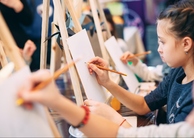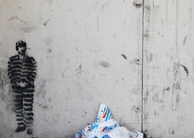Graphic Novels: Preparing for a Mulitmodal and Multiliterate WorldCummins (2011) recognizes that access to print does not inevitably lead to greater comprehension unless students “engage with the print” (p. 1978). Engagement, Guthrie et al. (1996) contend, is the integration of motivations and strategies of literacy activities. Graphic novels are a form of print-based media that offer readers the opportunity to combine textual decoding skills with their own visual literacies in the context of a culturally challenging narrative. As Chun (2009) explains, graphic novels, as opposed to traditional textbooks, “engage students’ attention and activate their imagination through the author’s use of multimodalities in presenting visually arresting narratives that feature the multilayered emotions and contradictions of the characters” (Chun, p. 147). Far from the “standardized and sanitized textbooks that strip away the interesting dramas and contradictions that constitute our histories” (Loewen, 1995, as cited in Chun, 2009, p. 147), graphic novels offer students a chance to consider a culturally challenging perspective that may not be offered by another medium. Students should not, however, be expected to engage in these texts alone. Not only may students need assistance in initially learning to read the sequential, yet non-linear paneling of the story (Chun, 2009), but the content of the novels provides the opportunity for, and are in fact necessary of, critical discussion. These discussions, essential for questioning and fully understanding the content (Cristensen, 2009), may also provide the impetus for engaging more students in the text. Guthrie (2004, as cited in Cummins, 2011) notes that, “engaged reading is often socially interactive insofar as engaged students are capable of discussion or sharing with friends despite the fact that much of their reading may be solitary” (p. 1977). Discussions that ask critical questions are key to ensuring that students are engaged in the story and are developing critical literacy skills. Such questions may include: Who were the people involved [in the story]? Who exercised agency and in what ways? Who has been omitted from this account? From whose perspective is this narrative told? […] How do the visuals and the written text complement/contradict one another? Is there more than one story told here? Would you call these stories competing or complementary stories? (Cromer & Clark, 2007, p. 588)One reason engaged students develop a higher level of reading comprehension, Guthrie et al. (2004) explain, “is that motivated students usually want to understand text content fully and, therefore, process information deeply” (p. 403). Though Cummins (2011) acknowledges that the effects of print access are mediated through literacy engagement, access to and engagement in printed text is a better predictor of literacy performance than socio-economic background (OECD, 2004, as cited in Cummins, 2011, p. 1978). This means that the use of alternative texts, especially those that give students a sense of ownership through intellectual and emotional engagement (Chun, 2009) do have the potential to over come the status quo in literacy education. Proposition 2: The Development of Bilingual Students’ L1 Proficiency Plays a Positive Role in L2 Academic DevelopmentCummins (2011) refutes a commonly surmised belief that a student’s L1 will inhibit academic achievement in L2. He claims that this misconception comes from a failure to take into account the multiple factors that mediate a students home and school language, most notably, socio-economic status and length of residence in the host country (p. 1982). Taking on the hotly debated issue of immigration, Boatright (2010), suggests that English language arts teachers “have a unique opportunity to seize upon this highly political and fiercely challenged issue by opening up their curricula to the theme of immigration in their classrooms” (p. 468). Using graphic novels as a point of entry to engage this dialogue, Boatright suggests that teachers can engage students in a critical literacy experience while at the same time learning literacy skills. Chun (2009) furthers this notion stating, “The development of literacy and critical literacy need not be independent of each other; in fact, they are mutually constitutive in a classroom that emphasizes the need to read the world in which we live” (p. 152). While Cummins (2011) summarizes the data advocating that bilingual instruction offers significant advantages over English-only programs, he recognizes that “bilingual education by itself is not a panacea for minority students’ educational difficulties,” nor is it possible to offer instruction in students’ L1 in most educational contexts, especially those “characterized by heterogeneity of minority populations” (p. 1980). He argues, however, that bilingual instructional strategies that aim to teach for cross-lingual transfer are entirely feasible even in L2-medium contexts. Many researchers (Boatright, 2010; Cary, 2004; Christensen, 2006; Chun, 2009; Danzak, 2011; Frey & Fisher, 2004) have used graphic novels and the comics medium as a means of reaching across the linguistic divide to draw on students L1 knowledge and multiliteracies practice. Danzak (2011) provides an excellent example of how students’ L1 serves as a valuable resource and meaning-making tool in reading and creating graphic stories in L2 literacy learning. In her Graphic Journeys project (2011) 32 ELL students from grades six to eight created graphic narratives representing memories of shared experiences, family stories and cultural meanings. Several components of the project encouraged students to use their L1. In the Collaboration and Family Involvement component for example, students conducted interviews about their family’s immigration experience. Conducting these interviews, Danzak states, “provided the students with the opportunity to incorporate varied linguistic modalities and languages (i.e., they used spoken and written English in class to construct interview questions and then spoke Spanish at home to interview their parents)” (p. 193). While instruction was conducted in English, the project encouraged the use of cross-lingual transfer “afford[ing] a voice to students who are frequently silenced in the traditional, monolingual, English-speaking classroom (2011, p. 195). Proposition 3: Societal Power Relations Play a Direct Causal Role in Promoting School Failure Among Students From Subordinated CommunitiesCummins (2011) points out a number of ways in which societal power relations negatively influence academic achievement of minority groups. In the context of the classroom, he states that power relations “ensure that curriculum, assessment, [and] teacher education will tend to reflect the values and experiences of dominant groups in society” (p. 1983). Breaking away from traditional literacy pedagogy which has long been restricted to formalized, monolingual, monocultural, and rule-governed forms of language (New London Group, 1996), graphic novels challenge traditional power relations in literature on a number of levels. The medium itself, along with the content and those who produce it, offer alternative representations of literature, providing the opportunity to mediate the underrepresentation of minority groups in traditional literacy instruction. In this way, the graphic novel, Schwarz (2010) explains, “retains much of its ‘outsider’ or alternative status, offering unexpected topics, diverse views of the world, and a challenge to readers’ complacency” (para 9). Along with the unconventional forms, language, and styles that graphic novels can take, their themes and content offer a progressive disposition. In reading traditional linear novels, students must rely entirely on their understanding of not only the text, which for ELL students can be daunting in and of itself (Cary, 2004), but also the underlying assumptions of the author (Cromer & Clark, 2012). Much of the content in graphic novels, however, offers original perspectives on history and society. Schwarz (2002) explains how graphic novels “present alternative views of culture, history and human life in general in accessible ways, giving voice to minorities” (p. 283). This notion of accessibility is especially pertinent in multilingual classes. Students who may be restricted from taking part in classroom discussions based on traditional linear texts may be better equipped to comprehend and relate to the content in graphic novels and thus be “able to take part in classroom discussions and contribute their unique insights” (Christensen, 2006, p. 228). Intent on enhancing literacy acquisition for adolescents from diverse backgrounds, Frey and Fisher (2004) present an example of how graphic novels were used as a means of embracing popular culture in a class of struggling readers and writers in a school in San Diego. In an effort to engage the ninth grade students, nearly all of whom were ELL and minority students, Frey and Fisher found that graphic novels offered recognizable stories and provided a visual vocabulary for scaffolding writing techniques. Approaching literacy teaching using this medium of popular culture, as opposed to worksheets focused on basic decoding skills, a signature of many remedial literacy classes, the authors aimed to access the multiple literacies held by the students. They found that the images combined with limited print allowed students to “read and respond to complex messages with text that better matched their reading levels” (p. 20). The authors began the course by using several stories based on the hardships of urban life from the perspective of immigrant minorities, a topic with which the students were familiar. Embracing the realities faced by the characters in these stories, as opposed to having students read content to which they cannot not relate, works to dismantle the institutionalized power relations in traditional literacy discourse. As Cummins (2011) states, “the ways in which teachers negotiate identities with students can exert a significant impact on the extent to which students will engage academically or withdraw from academic effort” (p. 1983). If students are made to understand that their cultures, heritage and current circumstances do count and are worthy of study and discussion, they will be more likely to engage in a discourse to which they feel they belong. Cautioning against pedagogies that call simply for “relevance” and “responsiveness” in literacy teaching, Paris (2012) suggests that it is necessary to look beyond the heritage and traditional practices of marginalized groups and consider as well “the shifting and changing practices of students and their communities” (p. 95). Paris identifies culture not as one static identity, but rather, dynamic and continually shifting identities. Reflecting this pedagogical principal in in the realm of graphic novels, Yahgulanaas says he uses the term “Haida Manga” with a degree of elasticity, "suggest[ing] that Haida cultural productions can adapt and evolve in an ever-shifting world without compromising their basic cultural integrity, thereby defiantly opposing pedestrian views of what is Indigenous or traditional” (Park, 2011, p. 6). Paris (2012) offers the term culturally sustaining pedagogies to embrace the cultural fluidity of students and to “support young people in sustaining the cultural and linguistic competence of their communities while simultaneously offering access to dominant cultural competence” (p. 95). Drawing on the notion of human agency and the dynamic nature of identity, Danzak (2011), in her Graphic Journeys project, embraces the notion of hybridity, “the crossing of conventional boundaries to create new cultural practices” (p. 188) which she states is present in ELL students’ “bilingualism and bicultural practices, as well as […] their innovative mixing and developing of new linguistic and cultural expressions” (p. 189).Continued on Next Page » Suggested Reading from Inquiries Journal
Inquiries Journal provides undergraduate and graduate students around the world a platform for the wide dissemination of academic work over a range of core disciplines. Representing the work of students from hundreds of institutions around the globe, Inquiries Journal's large database of academic articles is completely free. Learn more | Blog | Submit Latest in Education |


















